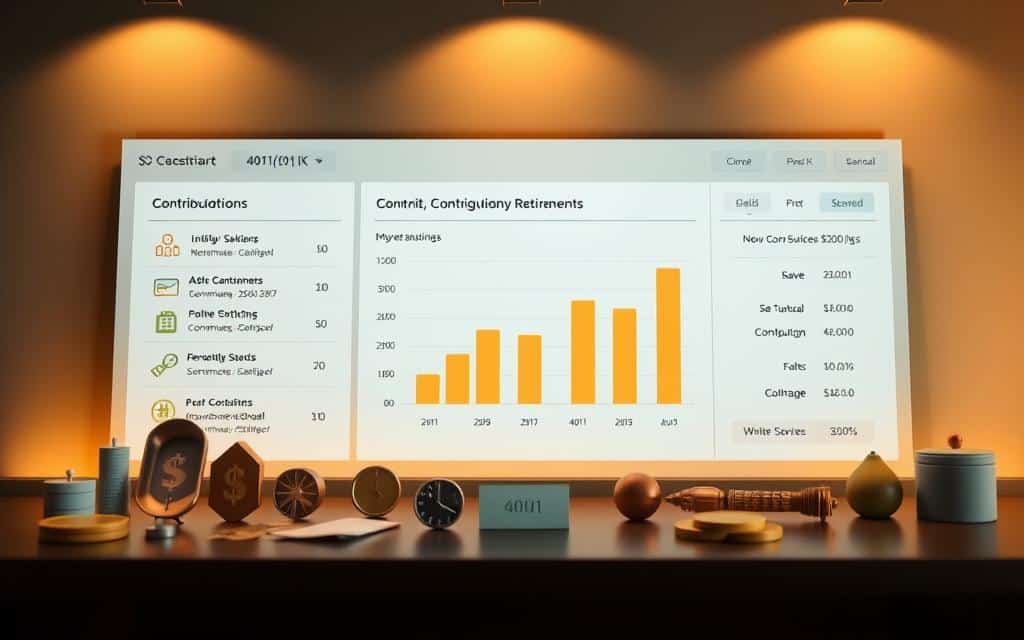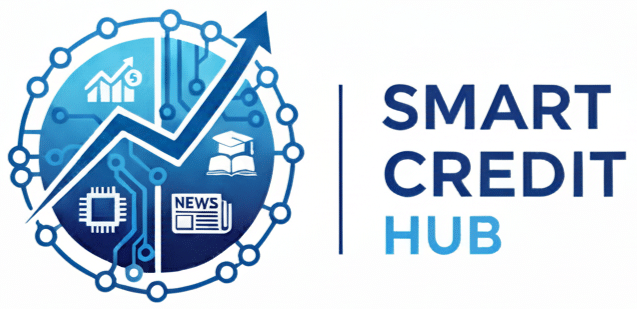Only 55% of workers in the private sector have a retirement account at work. Yet, these workplace plans hold trillions in retirement money. This shows how crucial Your Company’s 401(k) can be for your financial future.
Your Company’s 401(k) offers a way to save for retirement with many perks. It includes tax benefits, employer contributions, automatic savings, and professional fund management. These benefits help you prepare for retirement better than regular savings accounts.
Related content:
You will stay on the same website.
401(k) plans are important in the U.S. and follow federal laws. They are key to many people’s retirement plans. Millions count on them for income when they retire.
This article will cover the basics: how 401(k)s work, choosing investments, and how much to contribute. It will also explain employer matches, the effect of fees, withdrawal rules, and what to do when you leave a job. It includes ERISA protections and new trends in retirement planning.
You’ll learn how to get the most out of your company’s 401(k) plan. This includes picking the right investments, cutting costs, getting your full employer match, and changing your plan when needed.
Understanding the Basics of a 401(k)
A 401(k) is a retirement account set up by your employer. You save money for retirement directly from your salary. You can choose to save this money before or after taxes. These savings grow until you retire, based on your investment choices.
Saving is easy because it comes right out of your paycheck. Many employers have times when you can sign up. They might also automatically sign you up and increase your savings over time. This helps your retirement savings grow.
What is a 401(k)?
A 401(k) lets you save a part of your salary for retirement. With a Traditional 401(k), you pay taxes when you take the money out. A Roth 401(k) uses money you’ve already paid taxes on. You don’t pay taxes again on withdrawals. These accounts are managed by professionals.
Types of 401(k) Plans
There are several types of 401(k) plans. A Traditional 401(k) saves you tax now, and your employer might add to your savings. A Roth 401(k) uses money you’ve already paid tax on, but you don’t pay tax when you take it out. A Safe Harbor 401(k) makes employers contribute and helps them avoid discrimination tests.
The SIMPLE 401(k) is for small businesses and requires employer contributions. The Solo 401(k) is for people who work for themselves. It lets them save more. Different plans have different rules for how long before the money your employer adds is completely yours.
Key Terminology Explained
When we say ‘Participant,’ we mean an employee with a 401(k). ‘Employer match’ is money your company adds to your 401(k). The ‘Vesting schedule’ tells when you fully own your employer’s contributions.
‘Beneficiary designation’ is choosing who gets your 401(k) if you die. A ‘Plan administrator’ runs things, and the ‘Custodial account’ holds your savings. ‘Investment lineup’ shows your fund choices, like target-date funds for your retirement year.
‘Expense ratio’ is what you pay yearly for your fund. ‘Fiduciary responsibility’ means those in charge must look out for your best interest. ‘Required minimum distributions (RMDs)’ are must-take withdrawals starting at a certain age, updated for 2023–2024. ‘Portability’ lets you move your money without penalties.
This summary helps you get a basic understanding of your company’s 401(k). It’s key for planning your retirement savings.
The Benefits of Enrolling in Your Company’s 401(k)
Joining a workplace retirement savings program can really shape your financial future. By enrolling in a 401(k), you get tax perks, matching funds, and reliable investment choices. These features make 401(k)s essential for smart retirement planning.
Tax Advantages of Contributing
Putting money into a traditional 401(k) can lower your taxes for the year. This means you pay less tax now and your money grows over time. With a Roth 401(k), the money you put in has already been taxed, so you don’t pay taxes when you take it out in retirement. Both options help your savings grow more than a regular investment account would.
Not having to pay taxes on the growth each year means you can earn more over time. This can add up to a lot more money for retirement, especially if you pick your investments wisely.
Employer Match: Free Money for Your Future
Many employers will match part of what you put into your 401(k), like adding 50 cents for every dollar up to 6% of your salary. This is like getting a salary boost just for saving for retirement. Not making the most of this match is like turning down free money.
Employer matching can really speed up the growth of your savings. That’s why it’s key to contribute enough to get the full match. It’s one of the smartest retirement moves you can make.
Growing Your Savings with Compound Interest
Compound interest means earning interest on your interest. Starting early and including your employer’s match can turn your savings into a much larger amount over 20 to 30 years. It’s like a snowball effect with your money.
How long you save and how much you add to your savings are crucial. Saving consistently over a long time and increasing your contributions can lead to a bigger retirement fund. For many, a 401(k) is the easiest way to keep saving over the long haul.
How to Choose the Right 401(k) Investments
When you’re saving for retirement, knowing where to start matters. First, figure out your goals and how long until you retire. Then, decide how much risk you’re okay with. This will help you pick funds that fit your long-term goals and stress level.
Choosing funds for your 401(k) can be simpler than it seems. Start by looking at the available funds and their fees. Seek out broad, low-cost options that follow major indexes. Remember, 401(k)s are great because of the employer match and tax benefits.
Understanding Risk Tolerance
Risk tolerance varies with each person’s situation and goals. Young people can often risk more in stocks. Those closer to retirement may prefer bonds and cash to safeguard their savings.
Big names like Fidelity, Vanguard, and Charles Schwab have online quizzes. These can help you see how much risk you can handle. They suggest investment mixes that fit your risk level.
Diversification Strategies
It’s smart to spread your investments across stocks, bonds, and cash. This lowers risk. A common suggestion is to subtract your age from 100 or 110 to figure out stock percentage. Yet, some prefer a mix that’s tailored to them.
Target-date funds are a set-it-and-forget-it option. They shift investment focus as you get closer to retirement, perfect for those not wanting to micromanage.
Factors to Consider When Selecting Funds
When picking funds, compare index and actively managed ones. Look at fees, how often the investments turn over, and their long-term success. Low fees mean more savings over the years. Always check the fund’s details or official documents to understand costs and goals.
It’s usually wise to limit the amount of your employer’s stock you own. Most find broad index funds offer good diversification at a low cost.
Some tips: choose low-cost index funds for your main investments; pick target-date funds for simplicity; and check your funds often to make sure they still work for your plan and goals.
Maximizing Contributions to Build Wealth
To build wealth, start with smart choices in your employer’s retirement account. Know the IRS limits for 2023 and automate saving with payroll tools. Also, grab every dollar of employer match you can. This strategy boosts your overall retirement plan, making savings more dependable.

Contribution Limits for 2023
The IRS limit for 401(k) plans in 2023 is $22,500 for those under 50. Limits change yearly, so check IRS.gov to plan accurately.
Catch-Up Contributions for Older Workers
If you’re 50 or older, you can add $7,500 more to your 401(k) in 2023. This is great for catching up or boosting your savings as retirement gets closer.
Planning to retire soon? Catch-up contributions can really help. Use them wisely, especially if you’re also saving for emergencies or paying off debt.
Setting Up Automatic Contributions
Setting your savings on autopilot with payroll deduction is easy and consistent. Many plans also increase your contribution rate every year automatically.
While employers may suggest a savings rate, you can usually change it. To make the most of it, always save enough to get the full employer match.
To save smartly, always aim for the full employer match. Increase your savings with raises and balance your 401(k) with other investments for a solid plan.
The Role of Employer Matching Contributions
An employer match boosts your savings in a retirement account. It does this by adding company funds to what you save. This might be a full match up to a certain percent of your pay, or partly, like 50 cents for each dollar you save. This makes your retirement plan more valuable without costing you more.
How Employer Matches Work
The way matches are calculated can vary. A common approach is matching 100% of the first 3% you save, then 50% on the next 2%. The rules about when you own the matched funds, also called vesting, can differ too. Some plans give you full ownership immediately, while others spread it out over years.
The Importance of Taking Full Advantage
Employer matches are like extra pay for your future. Not using this benefit fully means less money for retirement and weaker 401(k) perks. Getting the entire match helps your savings grow faster, making a stronger retirement likely. Seeing the match as part of your pay helps achieve financial goals earlier.
Strategies to Optimize Matching Contributions
Save enough to get the full company match from the start. Check the plan’s details right when you are hired. Do this to make sure your savings and the match line up. When your salary goes up, increase how much you save. This keeps your take-home pay stable while your retirement fund grows.
Consider if extra savings should go into the retirement plan or elsewhere. If your employer’s match is high, fill that up first before saving in other spots. When getting a job offer, talk about the match. And ask HR or a union rep how the plan might improve.
The Impact of Fees on Your 401(k)
Fees can really eat into your 401(k) over time. It’s important to understand the charges that apply. You can find fee details in the plan’s documents or on Form 5500 filings.
Common Fees Associated with 401(k) Plans
Administrative fees help run the plan, shown as a set dollar amount or a percent of assets. Recordkeeping fees pay for handling account statements and transactions. Advisory fees compensate consultants for choosing funds and giving advice.
Investment fees are part of the expense ratios, fund loads, or manager fees in each fund.
How Fees Can Affect Your Retirement Savings
Fees can slow down your savings growth over time. Even a small increase in expense ratios can significantly reduce your savings. For instance, a 0.5% higher expense ratio could mean losing tens of thousands from your final amount.
It’s smart to compare the impact of fees on your ending balance. This can show how different funds and investment choices make a difference in your savings.
Finding a Low-Cost 401(k) Option
Searching for index funds and low-fee options from companies like Vanguard, Fidelity, and T. Rowe Price is a good start. Talk to your HR or plan leader for a detailed fee rundown and comparisons on the recordkeeper.
If your plan’s expenses are high, consider comparing it to an IRA for cheaper options. Request full fee details, check the expense ratios, and push for affordable fund choices to enhance 401(k) perks for everyone.
How to Access Your 401(k) Funds
Getting money from your 401(k) must be done carefully. Each employer and plan has different rules. Always read your plan’s summary and think about how actions affect your retirement savings.
Withdrawal Options for Hardship Cases
The IRS allows hardship withdrawals for big, immediate financial needs. Examples include paying for medical expenses, buying a home, covering tuition, and dealing with disaster damages. But, not all plans offer this, so check yours and be ready to show proof.
Proof can be bills, invoices, or statements. Before a hardship withdrawal is approved, you often need to show you’ve tried other ways to get the funds.
Loans vs. Withdrawals: Pros and Cons
Plan loans let you borrow from what you’ve saved. You can usually take up to 50% or $50,000, whichever is less. You pay it back through your paycheck, with interest going back to your account.
Taking a loan keeps your savings in the plan and dodges taxes. But, if you leave your job, you must pay it back fast. If not, it counts as a withdrawal and taxes and penalties may apply.
A withdrawal takes funds out of your account for good. Most times, you’ll pay ordinary income tax and maybe a 10% early withdrawal penalty. And the opportunity for those funds to grow is gone.
Understanding Taxes and Penalties
Withdrawals before age 59½ usually get taxed as income and may come with a 10% penalty. But, there are exceptions like leaving a job after 55 or having a disability. Roth 401(k) rules are a bit different; withdrawals can be tax-free if you’re 59½ and the account is five years old.
A rollover can delay taxes. Moving the money to an IRA or another plan within 60 days skips the immediate tax. Make sure your 401(k) plan allows this before starting a rollover.
Best advice: try other options before dipping into your retirement funds. Look into emergency savings, short-term loans, or employee help programs. Talk to your plan’s administrator and a tax advisor to understand the tax effects and how it fits with your long-term goals.
Managing Your 401(k) After Leaving a Job
When you switch jobs, deciding what to do with your 401(k) is important. Your decision affects your future retirement. You can leave your money in your old job’s plan, move it to your new job’s plan, roll it over to an IRA, or cash out. Each option has its own pros and cons, involving fees, investment choices, and taxes.

Transfer Options Explained
Look into your transfer options first. Leaving your funds with your old employer’s plan can be easy if allowed. Moving them to your new job’s 401(k) keeps things in one place. Rolling over to an IRA can give you more investment choices. But cashing out could lead to taxes and penalties, which might eat into your savings.
Leaving Your Money in Your Former Employer’s Plan
Some plans let ex-employees leave their money in the account. This option means your money can still grow tax-free. And you might get access to special funds from big names like Vanguard and Fidelity. Often, these plans offer low-cost options that help long-term saving.
However, you might have less control and face plan changes. Also, there could be issues if they merge plans or get rid of smaller accounts. Check if there’s a required minimum balance to keep your account open.
Rolling Over to an IRA: Benefits and Considerations
Switching to a rollover IRA can give you more investment choices and possibly lower fees. It also makes it easier to keep track of your money. If you roll over a traditional 401(k) to a traditional IRA, your tax benefits stay the same. But moving to a Roth IRA means you’ll owe taxes that year.
Choosing a direct rollover is best because it avoids taxes and penalties. An indirect rollover has a strict 60-day rule from the IRS. When thinking about an IRA rollover, look into the costs, the custodian’s reputation, and service fees.
- Verify company plan rules and any minimum balance limits.
- Request distribution or rollover paperwork from the plan administrator.
- Choose a direct rollover whenever possible to prevent withholding.
- Consider tax consequences, especially for conversions to a Roth IRA.
- Consult a tax advisor or financial planner for complex situations.
| Option | Typical Benefits | Common Drawbacks |
|---|---|---|
| Leave in former employer’s plan | Tax-deferred growth; access to institutional funds; minimal paperwork | Limited investment choices; possible plan changes; minimum balance rules |
| Roll over to new employer’s 401(k) | Keep workplace features; consolidate accounts; continued payroll options | New plan may have higher fees or fewer funds |
| Rollover IRA | Broader retirement fund options; possible lower fees; consolidated management | Roth conversions create taxable events; different creditor protections |
| Cash distribution | Immediate access to funds | Taxes, early withdrawal penalties, loss of future compounding |
The Importance of Regularly Reviewing Your 401(k)
Keeping your retirement plan on track means reviewing it every year. This helps spot the difference between short-lived market changes and major trends. Tools from places like Fidelity and Vanguard make it easy to check how your investments are doing and what you’re paying for them.
How to Assess Your Investment Performance
Once a year, see how your investments stack up against similar funds and benchmarks. Look at how much you’re spending in fees since they can lower your earnings. Adjusting your investments helps keep your risk level where you want it.
Don’t make hasty decisions based on short-term losses. Use statements and tools to check if your investments are growing as you expected.
The Role of Life Changes in Retirement Planning
Life events like getting married or changing jobs mean you should look at your retirement plan again. These changes can affect how much money you need and where it should go.
Let the people who manage your retirement plan know about these changes. You might also want to talk to a financial advisor, especially if things get complicated.
Adjusting Your Strategy as You Age
As you get closer to retirement, focus more on investments that bring in steady income and protect your savings. While some funds adjust automatically, you might need to make changes yourself to match your comfort with risk.
Think about how you’ll withdraw money and cover health care costs as you get older. Reevaluate whether things like bonds or annuities still fit your needs.
Try out different retirement scenarios using calculators and get advice from financial planners. Regular reviews help ensure your retirement savings are on the right track.
Legal Protections for Your 401(k)
Workers have special rules to protect their retirement savings. These rules help make sure plan sponsors and administrators act correctly. They ensure everyone gets fair details about investments and fees. This makes a strong retirement plan for employees.
Understanding ERISA and Your Rights
The Employee Retirement Income Security Act sets standards for retirement plans in private jobs. It makes sure those in charge do what’s best for plan members. They must pick smart investments and keep an eye on fees.
Documents explain your rights and what you’re entitled to know. You get to see how fees affect your savings. This helps you understand the costs linked to your plan.
What to Do If You Face Issues with Your Plan
First, look over your plan’s documents and yearly report. Keep all your records like emails and statements. Note any problems with your contributions or fees.
Talk to your plan administrator or HR for more information. If issues persist, file a formal complaint. Should your issue remain unresolved, take it up with the Department of Labor’s Employee Benefits Security Administration.
If someone hasn’t acted right or fees are too high, you might need to go to court. Getting advice from a lawyer helps with complex problems or big losses.
Resources for 401(k) Participants
Several places offer help to protect your retirement savings. The U.S. Department of Labor EBSA and IRS have guides on your rights and how plans should work. The Consumer Financial Protection Bureau has easy-to-understand tips on saving and fees.
Fidelity, Vanguard, and Charles Schwab have education centers. They help you track how your savings are doing, compare fees, and choose investments wisely.
If you’re still confused, a lawyer who knows about ERISA or a financial planner can help you figure things out.
The Future of Retirement Planning
Retirement is quickly evolving. Employers, along with regulators and tech companies, are changing saving methods. This part talks about important trends, shifts in the workplace towards financial health, and how employees can get ready for updates in retirement ages and benefits.
Trends Impacting 401(k) Plans
Features like auto-enrollment and auto-escalation are getting popular. More plans now have these to help people join in more and save better. Plans are also offering Roth 401(k) options more often so workers can manage tax risks better.
More people are using target-date funds and managed accounts. These choices make it easier for those without much time or know-how. Fintech tools are also making things better by providing detailed dashboards and advice tailored to each user.
New regulations focus on being clear about fees and demanding higher standards for fiduciaries. These efforts are meant to make costs lower and build trust. Employers might go for pooled employer plans (PEPs) to reduce paperwork and make coverage wider.
The Shift Towards Financial Wellness in the Workplace
Companies are now seeing retirement help as part of bigger wellness programs. They’re offering things like workshops, seminars at work, and online learning to help workers get more ready for retirement.
These programs also include help for saving for emergencies, paying off student loans, and getting financial advice. This full approach helps people save more consistently for the long term and improves how well workplace retirement savings plans work.
Preparing for Changes in Retirement Age and Benefits
Changes in populations and policy pressures are influencing when people retire. Because people are living longer and there’s pressure on Social Security, businesses and workers are having to think again about their plans. Many companies are switching from promised-benefit pensions to contribution-based models.
Workers need to look closely at their options for retirement funds and see how 401(k) benefits can be part of a larger plan. Getting ready involves using retirement planning services, spreading out savings, and staying aware of policy updates that could change retirement rules.
| Trend | Employer Action | Employee Benefit |
|---|---|---|
| Auto-enrollment / Auto-escalation | Enable default contributions and periodic increases | Higher participation, consistent growth in workplace retirement savings |
| Roth 401(k) expansion | Offer Roth and traditional contribution choices | Tax diversification for future income |
| Managed accounts / Target-date funds | Provide professional management and simplified options | Less decision fatigue, better alignment with retirement goals |
| Fintech integration | Adopt portals, apps, and personalized tools | Improved engagement and clearer paths to saving |
| Regulatory and fiduciary upgrades | Increase disclosure, consider PEPs and fiduciary outsourcing | Lower fees and more reliable retirement planning services |
| Holistic financial wellness | Combine retirement with emergency savings and coaching | Stronger financial resilience and better use of 401(k) benefits |
Case Studies: Success Stories with 401(k) Plans
These stories show how smart choices in Your Company’s 401(k) can boost retirement futures. They highlight tactics like getting the most from employer match, increasing savings over time, and choosing low-cost funds. Through each step, you can see how to get ready for retirement better.
Real-Life Example A: After getting raises, a mid-career engineer upped her contributions. She made sure to match her employer’s contribution and increased her savings by 1% each year. She also invested some of her money in a broad index fund. Thanks to her employer’s match and the growth of her savings, her retirement fund grew by 35% over 20 years, compared to if she hadn’t changed her savings rate.
Real-Life Example B: A sales manager nearing retirement increased his savings after turning 50. He combined his savings from three accounts into one and chose a more conservative investment mix. By picking a target-date fund, he simplified his investments and cut costs. This improved his savings enough that he might not need to work part-time when he retires.
Real-Life Example C: A teacher started with small automatic payments into low-cost index funds. She learned how to choose better retirement investments through webinars and planning tools offered by the plan. After 25 years, her careful choice of low-fee investments and regular contributions built a bigger savings account and gave her confidence about when to retire.
Lessons Learned from Participants
- Capture the full employer match to instantly increase your savings.
- Choose low-cost index funds and put all your savings in one place to save on fees.
- Adjust your investments to match your comfort with risk.
- Avoid taking money out early to let your savings grow and to lower taxes.
- Use automatic savings increases and have a clear goal for saving.
How Goals Were Achieved
- Set a clear goal for how much you need to save for retirement.
- Slowly increase how much you save until it’s just right.
- Divide your investments between stocks and bonds based on how soon you need the money.
- Make the most of tools and advice from employers and companies like Vanguard or Fidelity.
- Keep an eye on your savings goal and adjust your plan as needed.
| Scenario | Main Tactic | Typical Provider Tools | Measured Outcome |
|---|---|---|---|
| Mid-career employee | Auto-escalation + full employer match | Contribution escalation, match calculator | ~35% higher balance over 20 years |
| Near-retirement worker | Catch-up contributions + consolidation | Account rollover support, low-cost funds | Improved replacement ratio; lower fees |
| Early starter | Low-cost index allocation + education | Target-date funds, online planning tools | Greater long-term growth; higher confidence |
Research from Vanguard, Fidelity, and the Department of Labor shows how much match rates and fees can impact retirement savings. These cases prove that smart choices within an employee retirement plan can lead to big benefits.
Conclusion: Taking Charge of Your Retirement Through Your Company’s 401(k)
Using your company’s 401(k) helps with saving for retirement. It gives tax benefits and leads to security. Quick sign-up and matching the employer’s contribution are key. Choose investments wisely based on your comfort with risks. Keep an eye on fees and how your money is doing. Understanding when you can take money out or move it is also important.
Start by looking at how to join your company’s plan. Set contributions to start automatically. Make sure to do things like joining, matching contributions, and choosing investments right away. Workers can get help from retirement experts at work or outside. This helps create a plan that’s just for you.
A 401(k) plays a big role in retirement plans. Mix it with IRAs, regular savings, and planning for Social Security. This way, you make a strong retirement plan. Checking your plan often and making small changes can lead to big benefits later.



